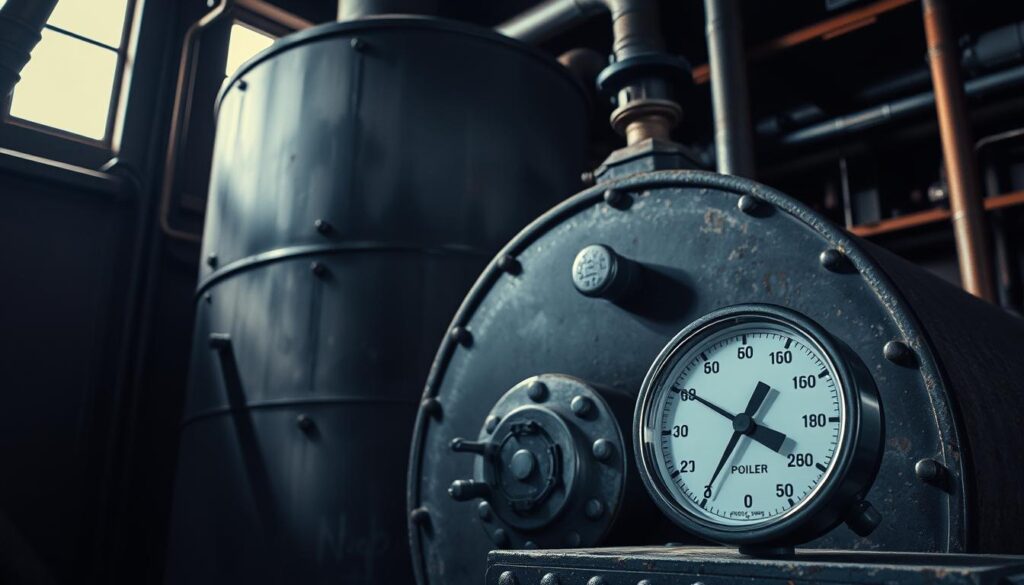Are you experiencing a drop in your heating system’s performance? Perhaps you’ve noticed the pressure gauge on your boiler fluctuating? Maintaining the correct pressure is crucial for the efficiency and longevity of your heating system.
If the pressure is not within the recommended range, it can lead to a range of issues, including reduced system performance and increased energy bills. Understanding the causes of pressure drops and how to address them is vital for homeowners in the UK.
Key Takeaways
- Recognising the signs of pressure drops in your heating system.
- Understanding the common causes of boiler pressure issues.
- Learning when to troubleshoot pressure problems yourself.
- Discovering the importance of maintaining the correct pressure for system efficiency.
- Preventing more serious boiler problems by addressing pressure issues promptly.
Understanding Boiler Pressure and Its Importance
Maintaining the right boiler pressure is essential for the longevity and efficiency of your heating system. The pressure within your boiler is a critical factor that affects how your central heating operates.
What is Boiler Pressure?
Boiler pressure refers to the force at which water circulates in your closed central heating system. It’s a measure that indicates how well your boiler is distributing heat. Proper pressure ensures that hot water is circulated efficiently throughout your home.
Optimal Pressure Ranges for UK Boilers
For most domestic central heating systems in the UK, the optimal boiler pressure is between 1 and 1.5 bar when the system is cool, rising to 2-2.5 bar when it’s hot. Maintaining pressure within this range is crucial for the effective operation of your boiler. Key aspects to consider include:
- The role of the expansion vessel in managing pressure as water heats and expands.
- The difference between standard, low, and high pressure situations in domestic boilers.
- How pressure impacts the efficiency and performance of your heating system.
Signs Your Boiler is Losing Pressure
Recognising the signs of low boiler pressure is essential for maintaining a functional heating system. If you’re experiencing problems, it’s likely related to a drop in pressure.
Visual Indicators on Your Pressure Gauge
The pressure gauge on your boiler is a critical component for monitoring its pressure. A typical pressure gauge has a green zone indicating the optimal pressure range and a red zone for dangerously high or low pressures. If the needle is in the red zone or near the lower end of the green zone, it may signal that your boiler is losing pressure. Regularly checking your pressure gauge can help you identify potential issues early on.
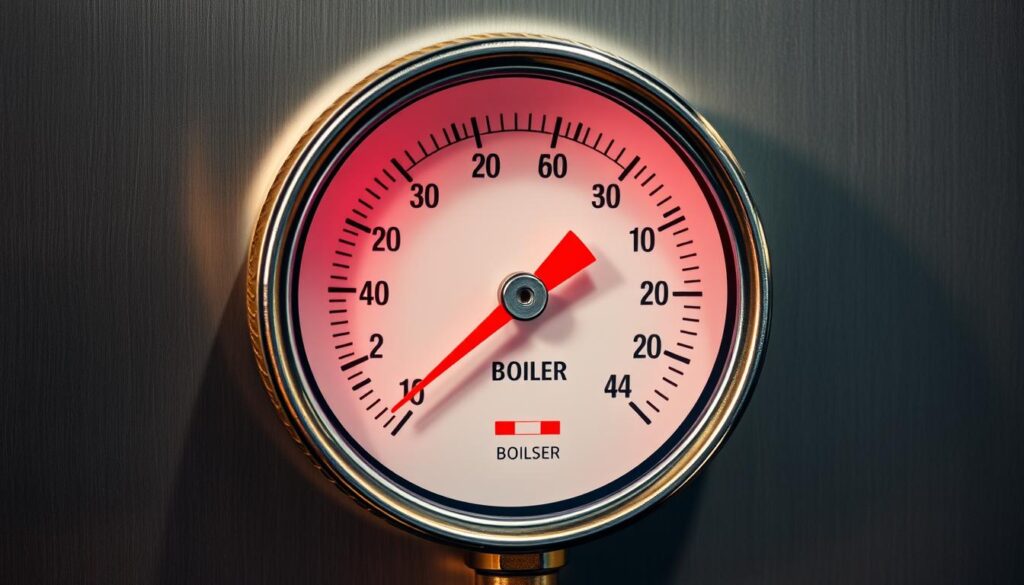
Performance Issues Caused by Low Pressure
When your boiler is experiencing low boiler pressure, you may notice several performance issues. For instance, your radiators might not heat up properly, or the water from your hot tap may not be warm. In some cases, your boiler might even turn itself off or display an error code. These signs indicate that your boiler is boiler losing pressure, and it’s crucial to address the issue to restore your heating system‘s efficiency.
- Lukewarm radiators despite the central heating being on
- Hot water not warming up as expected
- Boiler shutting down or showing error codes related to pressure
How to Check Your Boiler Pressure
Understanding how to check your boiler pressure is crucial for maintaining the efficiency and safety of your heating system. Checking the pressure gauge allows you to see whether your boiler pressure has dropped or risen.
Locating Your Boiler’s Pressure Gauge
The pressure gauge on your boiler is typically a clock-like face with coloured bars and numbers, usually ranging from 1.0 to 4.0. To locate it, look for this gauge on your boiler’s front panel. Some modern combi boilers or system boilers may have a digital display instead; refer to your user manual if you’re unsure.
Different types of boilers have the pressure gauge in varying locations. For combi boilers, it’s often on the front or top panel. System boilers usually have it on the front, near the controls. Conventional boilers might have it on the boiler itself or on the control panel.
Reading the Pressure Gauge Correctly
Once you’ve located the pressure gauge, check the needle’s position. If it’s in the green zone, your boiler pressure is correct. If it’s in the red zone, the pressure is either too low (before the green zone) or too high (beyond the green zone). For digital displays, the normal pressure range is usually indicated on the screen or in the user manual.
| Boiler Type | Normal Pressure Range | Gauge Type |
|---|---|---|
| Combi Boiler | 1.0 – 2.0 bar | Analogue/Digital |
| System Boiler | 1.0 – 1.5 bar | Analogue/Digital |
| Conventional Boiler | 1.0 – 2.0 bar | Analogue |
Common Causes of Boiler Pressure Drops
Several factors can contribute to a drop in boiler pressure, and diagnosing the root cause is key to resolving the issue. Your boiler’s pressure can be affected by various elements within your central heating system.
Recently Bled Radiators
Bleeding your radiators is a common maintenance task that can cause a temporary drop in boiler pressure. When you bleed a radiator, air is released from your central heating system, which can lower the pressure. This is a normal occurrence, and repressurising the system should resolve the issue.
Leaks in Your Central Heating System
A leak in your central heating system is a likely cause of a drop in boiler pressure. Leaks can occur in various parts of the system, including radiators, pipes, and boiler components. The type and location of the leak can affect the rate of pressure loss. Common areas where leaks occur include corroded or damaged pipes, faulty radiator valves, and loose connections.
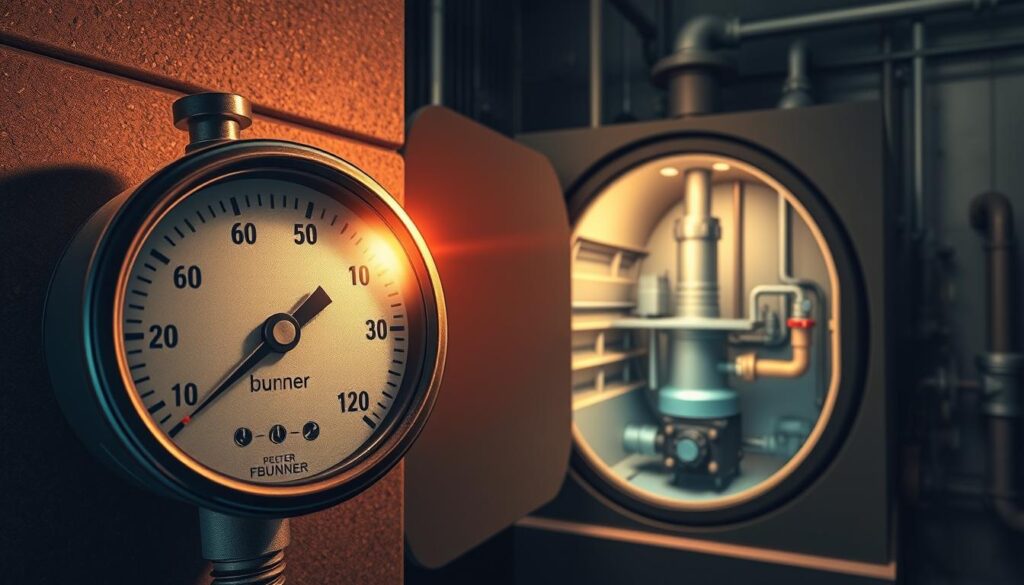
Internal Boiler Component Failures
Internal boiler components, such as the pressure relief valve or the heat exchanger, can fail over time, leading to pressure loss. Corrosion, wear, and tear can cause these components to malfunction, resulting in leaks or other issues that affect boiler pressure. Regular maintenance and inspection can help identify potential problems before they become major issues.
Understanding the causes of boiler pressure drops is essential for maintaining your heating system’s efficiency and preventing potential safety hazards. By identifying the root cause of the issue, you can take corrective action to restore your boiler’s pressure and ensure your central heating system operates smoothly.
How to Troubleshoot Boiler Pressure Drops
Troubleshooting boiler pressure drops requires a methodical approach to identify the root cause of the issue. To start, you should inspect your heating system for potential leaks and examine boiler components that may be causing the pressure to drop.
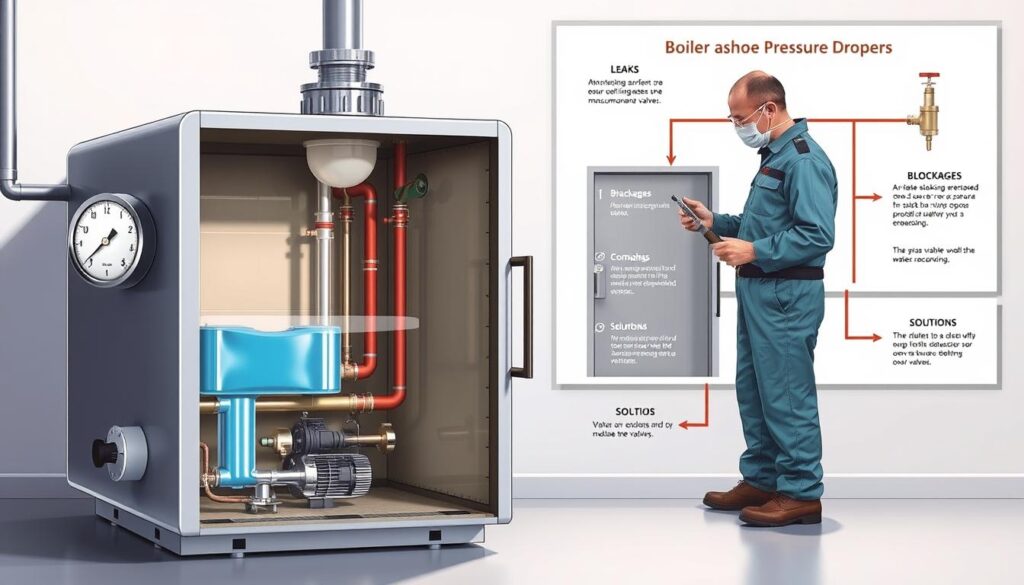
Inspecting Your Heating System for Leaks
Inspecting your heating system for leaks is a crucial step in troubleshooting boiler pressure drops. Leaks often occur at joints or fixtures, particularly where supply pipes are connected to radiators. Look for signs of leakage such as discolouration, staining, paint bubbling, or rust marks around radiators and pipes. Check for damp patches or water stains on walls and ceilings, which can indicate hidden leaks.
Checking Boiler Components
Checking boiler components is another essential step in troubleshooting pressure drops. Examine the pressure relief valve, as it is a common cause of pressure issues. Ensure that all connections and valves are secure and not damaged. If you’re unsure about how to inspect these components or if you find any signs of damage, it’s recommended to consult a professional.
Step-by-Step Guide to Repressurising Your Boiler

Restoring your boiler’s pressure is a simple task that requires some basic knowledge and caution. Before you start, ensure your boiler is turned off and has cooled down. This is crucial for safety and accuracy when repressurising.
Locating the Filling Loop
The filling loop is a hose that connects your boiler to the cold water supply. Its location may vary depending on your boiler type and configuration. Typically, it’s found near the boiler or sometimes hidden behind a panel. Consult your boiler’s manual if you’re unsure.
Safely Increasing the Pressure
To increase the boiler pressure, you’ll need to open the filling loop valves. This allows cold water to enter the system. Open the valves slowly to avoid adding too much pressure at once. Monitor the pressure gauge as you fill the system until the pressure rises to between 1 and 1.5 bars, which is usually indicated by the green zone on the gauge.
Confirming Successful Repressurisation
Once the pressure is within the optimal range (1-1.5 bar), close both valves of the filling loop. Check the system for any leaks and ensure that the pressure remains stable. If the pressure continues to drop, there might be a leak in your central heating system that needs to be addressed.
By following these steps, you should be able to repressurise your boiler successfully. Remember, if you’re not comfortable with this process or if the problem persists, it’s advisable to consult a Gas Safe engineer.
Finding and Fixing Leaks in Your Central Heating System
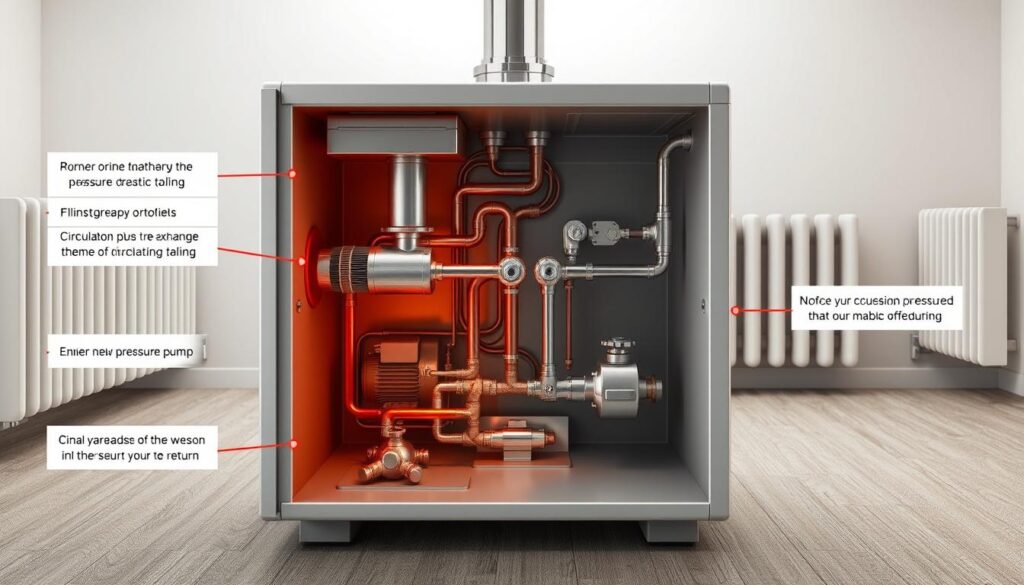
Leaks within your central heating system are a common cause of boiler pressure loss, requiring immediate attention. The boiler operates with a network of pipes and radiators, so the leak could be anywhere in your home. Identifying the source of the leak is the first step towards fixing it.
Common Leak Locations
Leaks tend to occur at the most vulnerable parts of your central heating system, such as joints and fixtures. Any pipework that connects to radiators is a common point for leaks. Look out for signs like discolouration, staining, paint bubbling or flaking, and rust marks around radiators and pipes. Swelling, bulging, or lifting of the skirting board and water stains on the ceiling below are also indicators of a leak.
Temporary vs. Permanent Fixes
While temporary fixes can address leaks in emergency situations, they are not a substitute for permanent repairs. For minor leaks, leak sealant products can be a solution until professional help is available. However, it’s crucial to address even small leaks promptly to prevent damage and ongoing pressure issues. Permanent repairs may involve replacing damaged pipes or tightening loose joints. It’s essential to identify the type of leak and the appropriate fix to ensure the longevity of your central heating system.
When to Call a Gas Safe Engineer
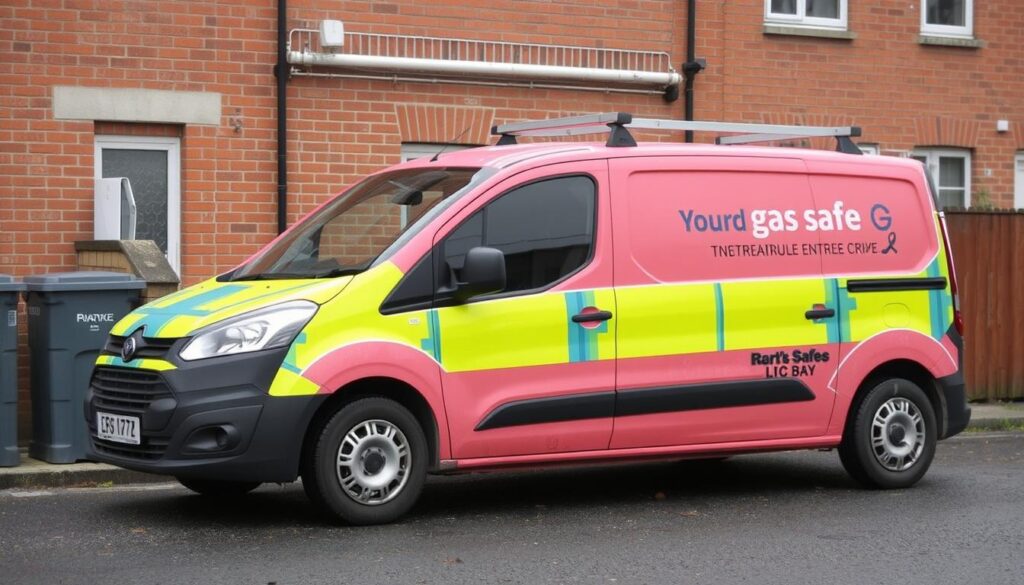
If your boiler continues to lose pressure despite repressurising, it’s crucial to seek the help of a Gas Safe registered engineer. This is a sign that there may be a more serious issue at play, requiring professional diagnosis and repair.
Warning Signs of Serious Boiler Issues
Be aware of the warning signs that indicate your boiler pressure issue requires professional attention. These include persistent pressure drops, signs of leaks, and unusual noises from your boiler or heating system. If you notice any of these symptoms, it’s essential to contact a Gas Safe engineer to assess and potentially repair your boiler.
What to Expect from a Professional Inspection
During a professional boiler inspection, the engineer will diagnose the cause of the pressure issue and perform necessary repairs. You can expect a thorough examination of your boiler and central heating system, including checks for leaks and assessments of boiler components. The engineer will provide guidance on the necessary repairs and ensure that your boiler is functioning safely and efficiently.
When hiring an engineer, ensure they are Gas Safe registered and have the necessary qualifications to address your boiler’s problem. Effective communication of the issues you’ve experienced is key to a successful repair.
Preventative Maintenance to Avoid Pressure Problems
Preventing pressure-related issues in your boiler requires a proactive approach. Regular maintenance is crucial to ensure your heating system operates efficiently and safely.
Regular Boiler Servicing
An annual boiler service by a Gas Safe engineer is vital to prevent unexpected problems. This service helps identify minor issues before they become major, ensuring your boiler operates within the optimal pressure range. Regular checks can also improve the lifespan of your boiler and reduce energy consumption.
Monitoring and Early Intervention
Monitoring your boiler pressure throughout the year, especially after seasonal changes, is essential. Ensure the expansion vessel is functioning correctly to maintain proper pressure. Bleeding radiators properly can prevent air buildup, which affects pressure regulation. By being proactive, you can avoid significant pressure drops and maintain a stable heating system.
